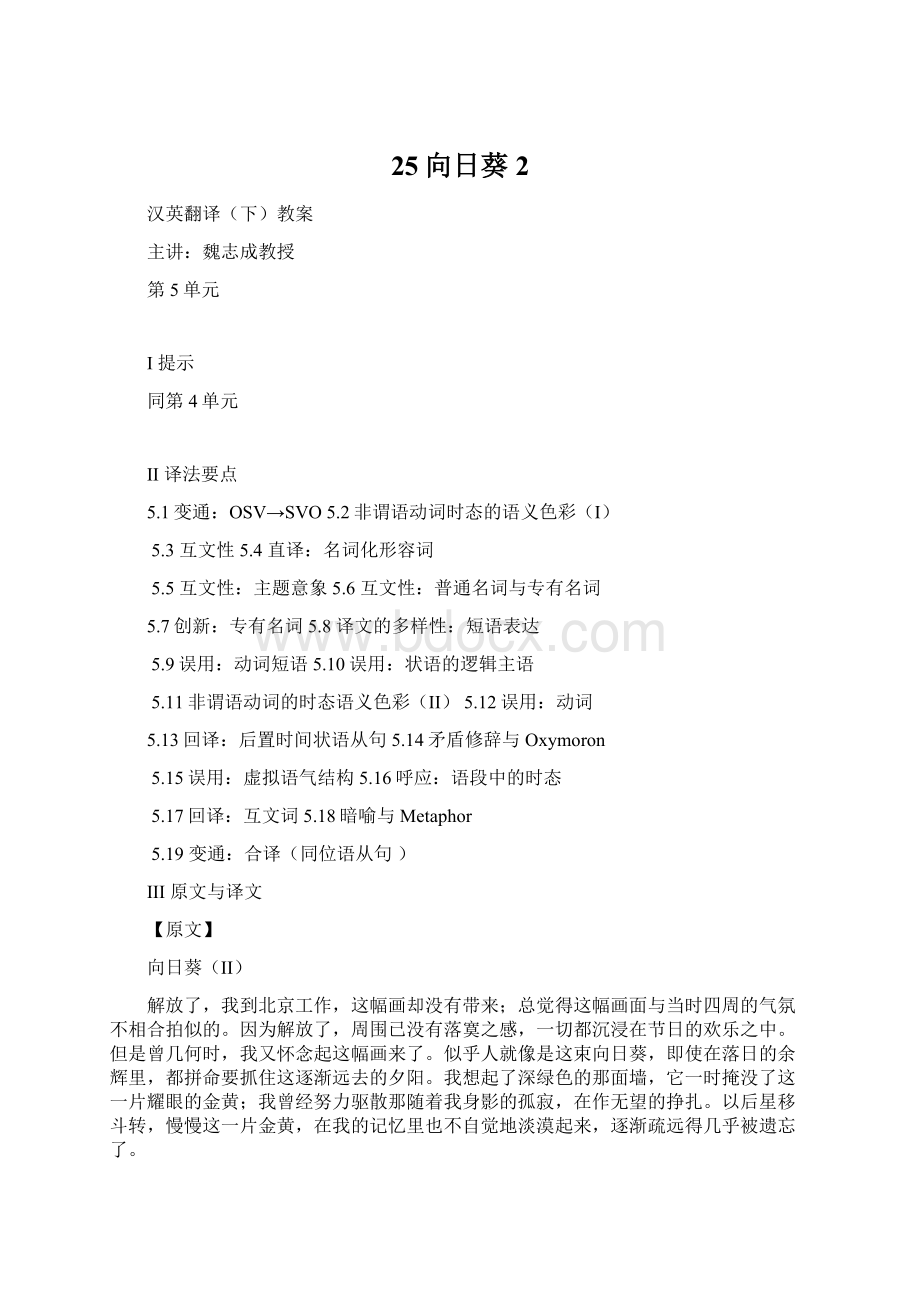25向日葵2.docx
《25向日葵2.docx》由会员分享,可在线阅读,更多相关《25向日葵2.docx(21页珍藏版)》请在冰豆网上搜索。

25向日葵2
汉英翻译(下)教案
主讲:
魏志成教授
第5单元
I提示
同第4单元
II译法要点
5.1变通:
OSV→SVO5.2非谓语动词时态的语义色彩(I)
5.3互文性5.4直译:
名词化形容词
5.5互文性:
主题意象5.6互文性:
普通名词与专有名词
5.7创新:
专有名词5.8译文的多样性:
短语表达
5.9误用:
动词短语5.10误用:
状语的逻辑主语
5.11非谓语动词的时态语义色彩(II)5.12误用:
动词
5.13回译:
后置时间状语从句5.14矛盾修辞与Oxymoron
5.15误用:
虚拟语气结构5.16呼应:
语段中的时态
5.17回译:
互文词5.18暗喻与Metaphor
5.19变通:
合译(同位语从句)
III原文与译文
【原文】
向日葵(II)
解放了,我到北京工作,这幅画却没有带来;总觉得这幅画面与当时四周的气氛不相合拍似的。
因为解放了,周围已没有落寞之感,一切都沉浸在节日的欢乐之中。
但是曾几何时,我又怀念起这幅画来了。
似乎人就像是这束向日葵,即使在落日的余辉里,都拼命要抓住这逐渐远去的夕阳。
我想起了深绿色的那面墙,它一时掩没了这一片耀眼的金黄;我曾经努力驱散那随着我身影的孤寂,在作无望的挣扎。
以后星移斗转,慢慢这一片金黄,在我的记忆里也不自觉地淡漠起来,逐渐疏远得几乎被遗忘了。
十年动乱中,我被谪放到南荒的劳改农场,每天做着我力所不及的劳役,心情惨淡得
自己也害怕。
有天我推着粪车,走过一家农民的茅屋,从篱笆里探出头来的是几朵嫩黄的向日葵,衬托在一抹碧蓝的天色里。
我突然想起了上海寓所那面墨绿色墙上挂着的梵高的《向日葵》。
我忆起那时家庭的欢欣,三岁的女儿在学着大人腔说话,接着她也发觉自己学得不像,便嬉嬉笑了起来,爬上桌子指着我在念的书,说“等我大了,我也要念这个”。
而现在眼前只有几朵向日葵招呼着我,我的心不住沉落又漂浮,没个去处。
以后每天拾粪,即使要多走不少路,也宁愿到这处来兜个圈。
我只是想看一眼那几朵慢慢变成灰黄色的向日葵,重温一些旧时的欢乐,一直到有一天农民把熟透了的果实收藏了进去。
我记得那一天我走过这家农家时,篱笆里孩子们正在争夺丰收的果实,一片笑声里夹着尖叫;我也想到了我远在北国的女儿,她现在如果就夹杂在这群孩子的喧哗中,
该多幸福!
但如果她看见自己的父亲,衣衫褴褛,推着沉重的粪车,她又作何感想?
我
噙着眼里的泪水往回走。
我又想起了梵高那幅《向日葵》,他在画这画时,心头也许远
比我尝到人世更大的孤凄,要不他又为什么画出行将衰败的花朵呢?
但他也梦想欢欣,
要不他为什么要用这耀眼的黄色作底呢?
梵高的《向日葵》已经卖入富人家,可那幅复制品,却永远陪伴着我的记忆;难免想起作画者对生活的疯狂渴望。
人的一生尽管有多少波涛起伏,对生活的热爱却难能泯灭。
阳光的金色不断出现在我的眼前,这原是梵高的《向日葵》说出了我未能一表的心思。
【译文】
译文1
Sunflowers(II)
AfterliberationIwastransferredtoBeijingtoworkandIfailedtobringthepicturewithme.AtthattimeIalwaysfeltthatthispicturedidnotsuitwiththesurroundingatmosphere.Forafterliberation,Ifeltnolonelinessbutimmersedandsurroundedbyhappiness.Beforelong,Ibegantomissthepictureagain.Itseemsasifmanislikethissunflower,eveninhisafter-lifehestillstrugglestograspthedepartingsun.Thus,Ithoughtofthedarkgreenwallandfeltithadabsorbedthisbrilliantgoldenlightforthetimebeing.Invain,Istruggledtodriveawaythislonelyfeelingwhichfollowedmelikeashadow.Withthelapseoftime,thesceneofgoldenyellowgraduallyfadedinmymemoryandslowlybecamesoestrangedthatitwasalmostforgotten.
DuringthetenyearsofturmoilhereIwassenttolabourinareform-through-labourfarminthesouthwasteland.EverydayItoiledbeyondmyphysicalcapacityandwassodismalatheartthatIbecameafraidofit.Oneday,whenIwaspushingadung-cartbyapeasant’shut,Inoticedsometenderyellowsunflowersstretchingtheirheadsoverthefenceintothevastbluesky.SuddenlyIwasremindedofVanGogh’s“Sunflower”hangingonthedarkgreenwallinmyShanghaiflat.Icouldrecallmyfamilyhappinessthenandmythree-year-oldgirlwhosaidsomethinginimitationofagrown-up’svoice.Whenshefoundherselfnotgoodatdoingso,sheburstoutlaughing.ShebentdownonthedeskandsaidpointingtothebookIwasreading:
”WhenIbecomeagrown-up,Iwanttoreadthisbook,too.”Now,therewereonlyafewsunflowerstogreetmebeforemyeyesandIfeltupsetatnotknowingwheretogo.Fromthenon,everydaywhenIwascollectingdung,Ialwaystookthatsamepath.Ididn’tmindifitmeantamuchlongerdistance.Ionlywantedtohavealookatallthesunflowerswhichweregraduallybecominggreyishyellowandreviewmypasthappiness.Onedaythepeasantscollectedtheripseedsandstoredthemaway.IrememberthatdaywhenIwaswalkingpastthatpeasant’shome,thechildrenonthefenceweresnatchingtheharvestfruits.AmidtheirlaughterIheardsomesharpcries.Ithoughtofmydaughterwhowaslivinginthefarnorthandhowhappyshewouldbeifshewasamongthosechildrenandtheirjoy!
Butifshesawherfatherpushingaheavydung-cartinshabbyclothes,whatwouldshehavethoughtof?
Ireturnedwithmyeyesfulloftears.IagainthoughtofVanGogh’spainting“Sunflower”.Maybewhenhewaspaintingthispicture,hewassufferingagreatloneliness.Ifnot,howcouldhehavepaintedsuchsunflowerswhichweregoingtofade?
Buthewastoodreamingofhappiness.Ifnot,whydidheusesuchabrilliantyellowcolourasthethebottom?
VanGogh’s“Sunflower”hasbeensoldtotherich,butthatreproductionwillalwaysliveinmymemory.Icannotrefrainfromthinkingaboutthepainter’scrazydesiretowardslife.Inspiteofthemanytwistsandturnsinlife,one’sloveforlifewillneverbeeliminated.Thegoldenraysofthesuncontinuouslyappearbeforemyeyes.ThisiswhatVanGogh’s“Sunflower”hasexpressedwhatIdidnotsay.
译文2
Sunflowers(II)
Afterliberationin1949IwastransferredtoBeijing.Ididnottakethepaintingwithme,asIfeltthatitwasquiteoutoftunewiththemilieuofthetime.Intheliberatedsocietywewereimmersedinafestivalatmosphereandtherewasnotslightestsuggestionofloneliness.ButsoonIbegantobemissingthepaintingagain.Itseemedasifman,likethisbunchofsunfloweres,wouldtrytohangontothesettingsuninitsafterglow.Ithoughtofthatdarkgreenwallthatseemedtohaveengulfedthebrilliantyellow.Itrieddesperatelytodispersethelonelinessthatfollowedmelikeashadowbutinvain.Withthepassageoftimethegoldenyellowinmymemorygrewdimandgraduallyitwasalmostforgotten.
Duringthechaotictenyears(1966-76)IwasbanishedtoafarminNanhuangtoreformthroughlabor.IwasforcedtoworkbeyondmyenduranceandIwasinsuchagloomystateofmindthatIoftenfoundmyselfscared.OnedayasIwaspushingadung-cartpastafarmer’sthatchedhut,Isawsomefreshyellowishsunflowers,againstabluesky,craningoutofitsfence.Theyremindedmeofthe“Sunflowers”onthedarkgreenwallinmyhouseinShanghai,callingbacktomindthejoysofthefamily:
ourthree-year-olddaughterwastryingtospeakthewayadultsdoand,whensherealizedthathermimickingwasfunny,shegiggledandthen,climbinguptothedeskandpointingtothebookIwasreading,said,“WhenIamgrown,Iwillreadthistoo.”Butnowinfronttherewereonlyafewsunflowersnoddingatmeandmyheartbegantosinkandfloataround,notknowingwheretostop.SincetheneachtimeIwentdung-collecting,Iwouldgoandpassthathutevenifitmeantmorewalkintheroundofmydailyjourney.Iwantedtoseethesunflowersthatwereturninggrayishyellow,reminiscingthecheerfulnessofthedaysgoneby,untilonedaythefarmergotthecropsin.WhenIpassedthefarmer’shutthatday,Iheardsomekidslaughingandscreamingoverthefence,eachtryingtogetafairshareoftheseedsfromthecrops.Ithenthoughtofmydaughterinthefarnorth.Howexcitedshewouldbeifshewereamongthekids,makingnoiseswiththem.However,ifshehadseenherowndadpushingtheheavydung-cartintheshabbyclothesastheywere,howwouldthathavemadeherfeel?
IwasonmywaybackwithtearsinmyeyesandmythoughtsturnedtovanGoghandhis“Sunflowers”again.Whenhewasworkingonthepainting,hemighthavefeltmorelonelinessandmiseryoflife,otherwisewhydidhepaintthepetalsabouttowither?
However,Ibelievedhehadalsodreamedofjoy,orwhyshouldhehaveplacedthepetalsagainstanintenseyellowbackground?
NowvanGogh’s“Sunflower”hasbecomearichman’sprivatepropertybutthatreproductionofthepaintinglivesoninmymemory,remindingmeoftheartist’scrazylustforlife.Thoughonehasupsanddownstofacedowntheroad,hisloveforlifeishardtofadeaway.ThatthegoldencolorofthesunshinekeepspoppingupbeforemyeyesisanindicationthatvanGogh’s“Sunflowers”speaksforwhatIhavebeenunabletobringoutfrommyheart.
IV比较分析与译法
(1)解放了,我到北京工作,这幅画却没有带来;总觉得这幅画面与当时四周的气氛不相合拍似的。
译文1AfterliberationIwastransferredtoBeijingtoworkandIfailedtobringthepicturewithme.AtthattimeIalwaysfeltthatthispicturedidnotsuitwiththesurroundingatmosphere.
译文2Afterliberationin1949IwastransferredtoBeijing.Ididnottakethepaintingwithme,asIfeltthatitwasquiteoutoftunewiththemilieuofthetime.
5.1变通:
OSV→SVO
由于形态标记的不丰富,汉语句法分析常常不得不依据语义逻辑来进行;因此有时
候一个句子有多种分析的可能。
譬如原文“这幅画却没有带来”一句就有可能分析为两种结构:
一种为无形态的SVC被动句,一种为OSV主动句----其中S主语“我”承前句而省。
译文1、2倾向于后一种理解,这是因为OSV在汉语中是因为修辞需要而产生的一种常用变式句型;英语虽然也存在相应的变式,但是使用的频率远不及汉语高;因此在句型转换时,汉语OSV常常需要被转换为英语常式SVO(魏志成.2003:
296)。
请分析类似的例句:
[286]我们又是四处飘流的人,遇着要远徙他方的时候,我们的鸡不能带着同走。
(郭
沫若《菩提树下》。
“我们的鸡不能带着同走”一句为OSV,其中S主语“我们”承前句主语“我们”而省。
张培基英译:
Weareafamilyconstantlyonthemove.Whenwetraveltoafar-awayplace,wecan’ttakeourchickenswithus.)
(2)因为解放了,周围已没有落寞之感,一切都沉浸在节日的欢乐之中。
但是曾几
何时,我又怀念起这幅画来了。
译文1Forafterliberation,Ifeltnolonelinessbutimmersedandsurroundedbyhappiness.Beforelong,Ibegantomissthepictureagain.
译文2Intheliberatedsocietywewereimmersedinafestivalatmosphereandtherewasnotslightestsuggestionofloneliness.ButsoonIbegantobemissingthepaintingagain.
5.2非谓语动词时态的语义色彩(I)
英语动词时态的语义色彩非常丰富,谓语动词是如此,非谓语动词更是如此。
与英
语相比,汉语的意合性限制了汉语在表达动作时间概念上精确性,因此汉语动词时态的语义色彩也就没有英语那么多层次。
汉英翻译时,我们在注意谓语动词时态的语义转换同时,还应该尽力注意非谓语动词时态的语义转换,虽然从深层的思维方式来讲,这是一个容易忽视的问题。
如原文“我又怀念起这幅画来了”一句,译文1处理为Ibegantomissthepictureagain,译文2为Ibegantobemissingthepaintingagain,虽然两者的差别仅仅在于一个不定式的进行式(即译文2的tobemissing),但是这个不定式的进行式却反映了译文2对非谓语动词时态语义色彩转换的深刻理解。
英语不定式的进行式语义色彩包括:
(一)不定式的进行式表示动词正在进行,如:
[287]Theyaresaidtobebuildinganotherbridgeacrosstheriver.
(二)不定式的进行式表示一个反复发生的动作,并且含有诸如赞叹、厌烦等感情,
如:
[288]Idon’tlikeyoutobeconstantlyarguingabouttrifles.
(三)不定式的进行式表示强调情况的暂时性,如:
[289]Youaretooyoungtobemeetingyoungmen.
译文2所使用的tobemissing,属于上述情况的第二类,有明显的感情色彩,把原文“怀念”的情绪表达得很到位。
(3)似乎人就像是这束向日葵,即使在落日的余辉里,都拼命要抓住这逐渐远去的夕阳。
译文1Itseemsasifmanislikethissunflower,eveninhisafter-lifehestillstrugglestograspthedepartingsun.
译文2Itseemedasifman,likethisbunchofsunfloweres,wouldtrytohangontothesettingsuninitsafterglow.
5.3互文性
“互文性”(intertextuality)是法国后结构主义文艺批评家JuliaKristeva提出的一个
概念,指的是一个文本总会同别的文本发生这样或